29 Search Results for augmented input
April 14, 2016
by Carole Zangari -
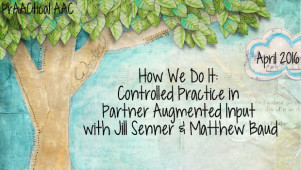
Today, we welcome back Dr. Jill Senner and Matthew Baud to talk about some of their strategies for implementing AAC. They have some great ideas for helping partners better support AAC learners. You can read some of their previous posts here. In the meantime, let’s see how they are helping communication partners develop their AAC facilitation skills. :::::::::::::::::::::::::::::::::::::::::::::::::::::::::::: Most of us already know that evidence-based research supports the use of partner-augmented input (PAI) as an intervention strategy for individuals who use AAC. However, simply having awareness of a strategy does not mean that one can easily use it. To quote Jim Knight, “We wouldn’t teach someone to drive by giving them a lecture, tossing them a book, and then turning them loose on the freeway.” Indeed, in order to learn a new skill, communication partners often need practice. In fact, one may need to try a new strategy or skill... [Read More...]
April 9, 2015
by Carole Zangari -
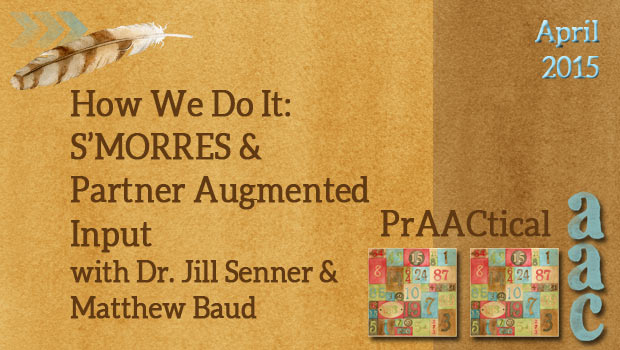
Mnemonics are such a great memory aid, so when Dr. Jill Senner and Matthew Baud offered to share the visual support that they use in their clinical work, I knew it would be of interest to many of you. Combine that with content on partner training, and we have a real treat for you: S’MORRES. Dr. Senner is the owner of Technology and Language Center where she specializes in providing AAC and AT services including assessment, consultation and training, and workshops/lectures. She has presented at numerous national AT conferences and has taught graduate courses in AAC and swallowing disorders. Matthew Baud is the Assistive Technology Coordinator at Niles Township District for Special Education, performing evaluations, trainings and coaching communication partners. Matthew also has his own AAC private practice, and is an adjunct professor at Saint Xavier University where he teaches a graduate course in AAC. In this post, they share S’MoRRES, a strategy for building... [Read More...]
August 3, 2014
by Carole Zangari -
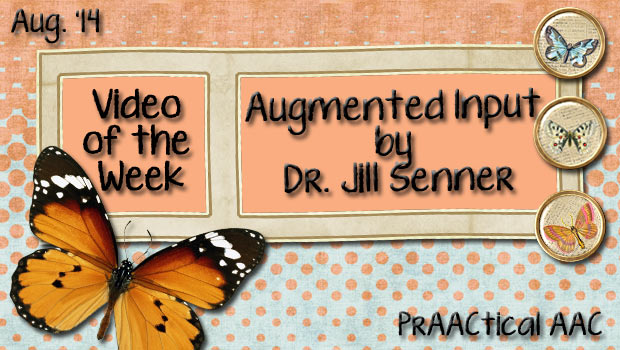
Work with learners who have difficulty processing language and are just learning to use their AAC systems? Dr. Jill Senner has a strategy for you! Thanks to DynaVox for hosting this terrific presentation. Direct link to video: http://www.dynavoxtech.com/training/toolkit/details.aspx?id=261
May 31, 2018
by Carole Zangari -
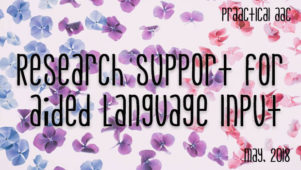
Aided language input, the practice of modeling AAC when speaking to those who are trying to learn AAC, is a pivotal intervention strategy. It has been shown to support comprehension and expression, and the development of early sentence forms. The evidence suggests it may also support the development of certain grammatical morphemes and verb combinations. You can learn more about the implementation of aided language input here. Here are some of the research studies that support the use of this evidence-based practice. Binger, C., & Light, J. (2007). The effect of aided AAC modeling on the expression of multi-symbol messages by preschoolers who use AAC. Augmentative and Alternative Communication, 23, 30–43. Binger, C., Maguire-Marshall, M., & Kent-Walsh, J. (2011). Using aided AAC models, recasts and contrastive targets to teach grammatical morphemes to children who use AAC. Journal of Speech, Language and Hearing Research, 54, 160–176. Dada, S., & Alant, E. (2009). The... [Read More...]
March 8, 2018
by Carole Zangari -
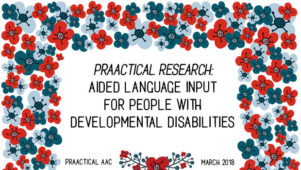
We’re pleased to welcome back Dr. Kathy Howery for another analysis of an AAC research article. Kathy is based in Alberta, Canada, and has worked in the field of AT and special education for over three decades. In the past year, she completed her doctoral studies where she used phenomenological methods to seek to understand the lived experience of speaking with/through a speech generating device. Kathy is currently working as a consultant to schools and school districts across Alberta focusing primarily on children and youth with complex communication needs. ::::::::::::::::::::::::::::::::::::::::::::::::::::::; Allen, A. A., Schlosser, R. W., Brock, K. L., & Shane, H. C. (2017). The effectiveness of aided augmented input techniques for persons with developmental disabilities: A systematic review. Augmentative and Alternative Communication, 33, 149-159. What this Article is All About (The Focus of the Research) This article presents the results of a systematic review of the research into what the authors refer... [Read More...]
April 29, 2016
by Carole Zangari -
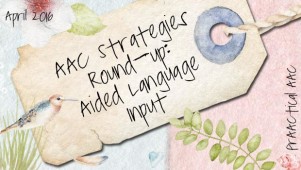
We’ve been writing about aided language input, a pivotal strategy for supporting AAC learners, for several years. In fact, there are over 200 posts tagged with this term. In this post, we gather together some of the most popular posts on this fundamental intervention strategy. Implementation A PrAACtical Idea for Aided Language Input Using Aided Language Input to Build Communication Opportunities! How I Do It: Implementing Aided Language Input with Alicia Garcia Pivotal Skills for AAC Intervention: Aided Language Input How We Do It: Controlled Practice in Partner Augmented Input with Jill Senner & Matthew Baud Text-Based Aided Language: Making the Literacy-Communication Connection for Children with Autism Videos PrAACtical Resources: Video Explainers for Aided Language Input Video of the Week: Aided Language Input with Gail Van Tatenhove Video of the Week: Aided Language Input with Dr. Caroline Musselwhite PrAACtical Resources: Video Examples of Aided Language Input Aided Language Input in... [Read More...]
March 28, 2016
by Carole Zangari -
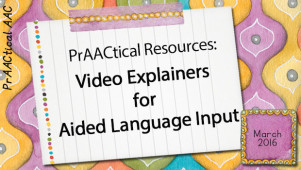
A growing number of clinicians, families, and educational teams are prioritizing the use of aided language input as a foundational strategy for AAC learners. When we first started writing about this strategy, it was rare to see adults using AAC to talk with AAC learners.Consistent implementation is still a challenge, but more and more of you are speaking AAC to teach AAC. And quite of few of you are doing your best to influence other stakeholders to support augmented communicators in this way. If you are doing inservices, teaching classes, or guiding teams toward better AAC intervention, the videos listed below may be useful to you in those efforts. Chris Bugaj developed this clear and engaging cartoon explaining the concept for people new to this strategy. Caroline Musselwhite recorded a full webinar with detailed information on aided language input. Communicare, a clinical practice with a strong focus on AAC,... [Read More...]
July 6, 2020
by Carole Zangari -
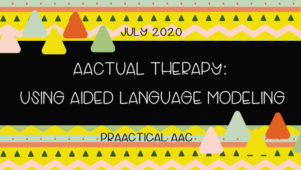
Although we’ve written extensively on the role of modeling in AAC, there are always new perspectives to consider regarding this evidence-based and widely-used strategy. Today, we feature SLPs Kate Grandbois and Amy Wonkka who share their approach to aided language modeling. :::::::::::::::::::::::::::::::::::::::::::::::::::::::::::::::::::::::: Bringing it all Together: Aided Language Modeling Most SLPs working in AAC have come across a variety of different interventions in their practice. Some, like aided language modeling, are popular and commonly seen at conferences. They are the most popular option on the intervention buffet. Others, like discrete trial training, are like the mystery meat – you think you know what it is, you don’t think you’re going to like it, and you’re going to watch while someone else tries it first. Sometimes these teaching procedures are straightforward, and sometimes they are confusing, intimidating, or complicated. You may find that choosing which intervention to use is influenced by... [Read More...]
May 7, 2020
by Carole Zangari -
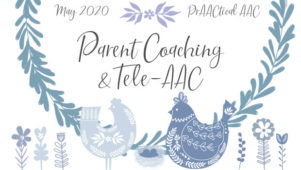
If I had a crystal ball, I wouldn’t be at all surprised if it told us that telepractice in AAC is here to stay. My guess is that when schools and clinics re-open there will still be a role for remote AAC services. That’s why I am so pleased that guest authors Jill Senner and Matthew Baud are returning to these pages to share their approach to using tele-AAC to educate and coach parents. Tele-AAC for All With social distancing, local shelter in place orders, and general concerns about the health of our high-risk clients who use AAC, most of us have made an abrupt transition to providing AAC therapy via telehealth. Doing direct therapy using video conferencing platforms might be going swimmingly for some clients who will sit and attentively gaze at the books, games, and other materials you present remotely. However, what about your younger clients? Or kiddos... [Read More...]
February 17, 2020
by Carole Zangari -
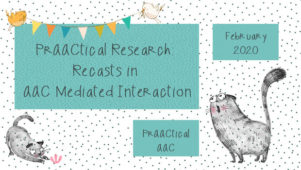
Today, we welcome back guest author Dr. Kathy Howery for another wonderful discussion of an important AAC research article. Dr. Howery’s work in AT and special education spans three decades and her research uses phenomenological methods to increase our understanding of the lived experience of people who use AAC. She works with the Ministry of Education low incidence team, and as a consultant to schools and school districts across Alberta focusing primarily on children and youth with complex communication needs. In this post, Dr. Howery reviews an important article describing research on recasting in AAC mediated conversations. Recasts in AAC Mediated Interaction Soto, G., Clarke, M. T., Nelson, K., Starowicz, R., & Savaldi-Harussi, G. (2020). Recast type, repair, and acquisition in AAC mediated interaction. Journal of Child Language, 47, 250-264. https://doi.org/10.1017/S03035000919000436 What this article is about (the focus of the research)? This article focuses its attention on the power of... [Read More...]









